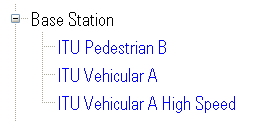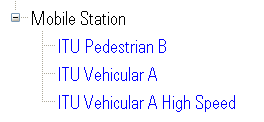



The Mobile WiMAX® channel model and the associated path delay profiles are specified in the WiMAX Forum Mobile RCT-Wave 2 Amendment. The multipath fading is modeled as a tapped-delay line with 6 taps with non-uniform delays. For each tap, the method of filtered noise is used to generate a matrix of time-varying channel coefficients with the correct distribution and spectral power density corresponding to your selected correlation type. The Classical Doppler spectrum and Rayleigh amplitude distributions are used.
The following predefined configurations are based on the ITU-R M.1225 standard.
|
ITU Pedestrian B (3 km/h) |
||||
|
Path |
Delay
|
Rel Loss |
Mean AoA |
Mean AoD |
|
1 |
0.0 |
0.0 |
147.34 |
18.11 |
|
2 |
0.2 |
0.9 |
50.84 |
24.48 |
|
3 |
0.8 |
4.9 |
139.08 |
21.11 |
|
4 |
1.2 |
8.0 |
49.50 |
6.47 |
|
5 |
2.3 |
7.8 |
260.03 |
23.85 |
|
6 |
3.7 |
23.9 |
128.93 |
24.24 |
|
Total AS |
|
|
67.91 |
4.99 |
|
ITU Vehicular A (60 km/h) |
||||
|
Path |
Delay |
Rel Loss |
Mean AoA |
Mean AoD |
|
1 |
0.0 |
0 |
142.22 |
165.11 |
|
2 |
0.31 |
1 |
13.92 |
170.43 |
|
3 |
0.71 |
9 |
110.94 |
182.2 |
|
4 |
1.09 |
10 |
45.25 |
162.44 |
|
5 |
1.73 |
15 |
98.38 |
170.6 |
|
6 |
2.51 |
20 |
50.41 |
155.68 |
|
Total AS |
|
|
69.9 |
4.99 |
This is the ITU Vehicular A channel model with the delay on the last tap moved from 2150 ns to 10,000 ns, for support of long channel impulse response or for a fast-moving mobile terminal (120 km/h).
|
ITU Vehicular A High Speed (120 km/h) |
||||
|
Path |
Delay |
Rel Loss |
Mean AoA |
Mean AoD |
|
1 |
0.0 |
0 |
142.22 |
165.11 |
|
2 |
0.31 |
1 |
13.92 |
170.43 |
|
3 |
0.71 |
9 |
110.94 |
182.2 |
|
4 |
1.09 |
10 |
45.25 |
162.44 |
|
5 |
1.73 |
15 |
98.38 |
170.5 |
|
6 |
10 |
20 |
50.41 |
155.68 |
|
Total AS |
|
|
69.9 |
4.99 |